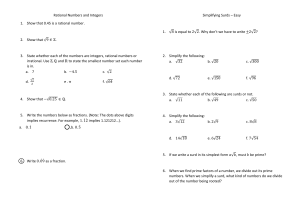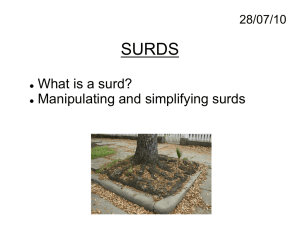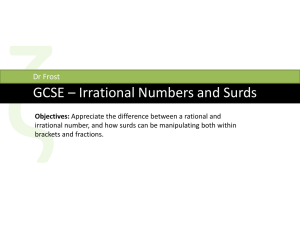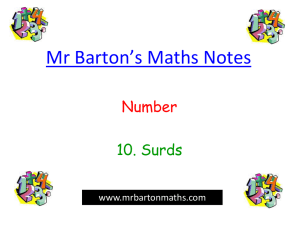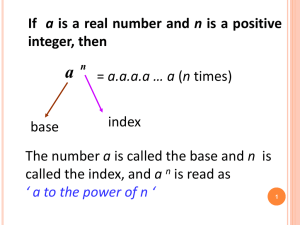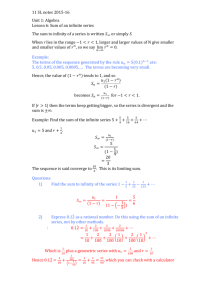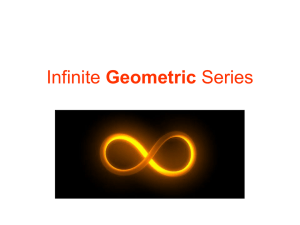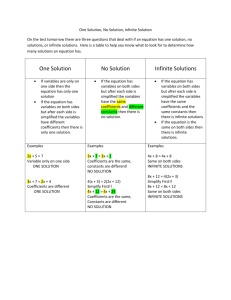SL Portfolio-Infinite Surds
advertisement
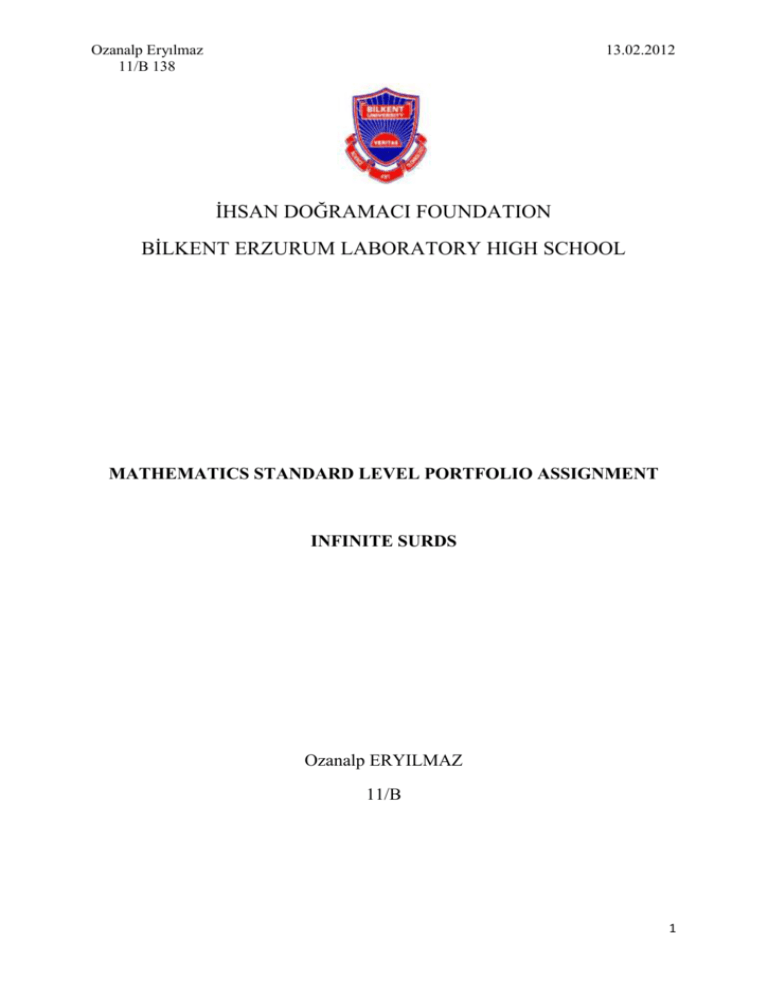
Ozanalp Eryılmaz 11/B 138 13.02.2012 İHSAN DOĞRAMACI FOUNDATION BİLKENT ERZURUM LABORATORY HIGH SCHOOL MATHEMATICS STANDARD LEVEL PORTFOLIO ASSIGNMENT INFINITE SURDS Ozanalp ERYILMAZ 11/B 1 Ozanalp Eryılmaz 11/B 138 When we consider the expression √𝑘 + √𝑘 + √𝑘 + √𝑘 + √𝑘 + ⋯ 13.02.2012 as an infinite surd and we can see that for different values of k, results are all in a pattern. In this portfolio assignment, I will find a general term for the exact value of the general infinite surd in terms of k and justify my results using different examples. The following expression is an example of an infinite surd. √1 + √1 + √1 + √1 + √1 + ⋯ Consider this surd as a sequence of terms αn where: α1 = √1 + √1 α2 = √1 + √1 + √1 α3 = √1 + √1 + √1 + √1 etc. Find a formula for αn+1 in terms of αn: By looking at the first 3 terms of the sequence we can write a general formula for αn+1 in terms of αn: αn+1 = √1 + 𝛼𝑛 Calculate the decimal values of the first 10 terms of the sequence: α1 = √1 + √1 = 1, 41421 α2 = √1 + √1 + √1 = 1, 55377 α3 = √1 + √1 + √1 + √1 = 1, 59805 2 Ozanalp Eryılmaz 11/B 138 13.02.2012 α4 = √1 + √1 + √1 + √1 + √1 = 1, 61185 √ α5 = 1 + √1 + √1 + √1 + √1 + √1 = 1, 61612 √ α6 = 1 + 1 + √1 + √1 + √1 + √1 + √1 = 1, 61744 √ √ α7 = 1 + 1 + 1 + √1 + √1 + √1 + √1 + √1 = 1,61785 √ √ √ α8 = 1 + 1 + 1 + 1 + √1 + √1 + √1 + √1 + √1 = 1, 61798 √ √ √ √ α9 = 1 + 1 + 1 + 1 + 1 + √1 + √1 + √1 + √1 + √1 = 1, 61802 √ √ √ √ √ α10 = 1 + 1 + 1 + 1 + 1 + 1 + √1 + √1 + √1 + √1 + √1 = 1, 61803 √ √ √ √ √ etc. Using technology, plot the relation between n and αn. Describe what you notice. What does this suggest about the value of αn ‒ αn+1 as n gets very large? Use your results to find the exact value for this infinite surd. 3 Ozanalp Eryılmaz 11/B 138 13.02.2012 Relation of an - n 1.65 1.6 an 1.55 1.5 Series1 1.45 1.4 0 2 4 6 8 10 12 n As the value of n increases the difference between αn and αn+1 decreases. If n gets very large, it means the difference will be 0. Consider another infinite surd √2 + √2 + √2 + √2 + ⋯ where the first term is √2 + √2. Repeat the entire process above to find the exact value for this surd. b1 = √2 + √2 = 1, 84775907 b2 = √2 + √2 + √2 = 1,96157056 b3 = √2 + √2 + √2 + √2 = 1, 99036945 b4 = √2 + √2 + √2 + √2 + √2 = 1, 99759091 √ b5 = 2 + √2 + √2 + √2 + √2 + √2 = 1, 99939764 4 Ozanalp Eryılmaz 11/B 138 13.02.2012 √ b6 = 2 + 2 + √2 + √2 + √2 + √2 + √2 = 1, 99984940 √ √ b7 = 2 + 2 + 2 + √2 + √2 + √2 + √2 + √2 = 1, 99996535 √ √ √ b8 = 2 + 2 + 2 + 2 + √2 + √2 + √2 + √2 + √2 = 1, 99999059 √ √ √ √ b9 = 2 + 2 + 2 + 2 + 2 + √2 + √2 + √2 + √2 + √2 = 1, 99999765 √ √ √ √ √ b10 = 2 + 2 + 2 + 2 + 2 + 2 + √2 + √2 + √2 + √2 + √2 = 1, 99999941 √ √ √ √ √ etc. 5 Ozanalp Eryılmaz 11/B 138 13.02.2012 bn Relation of bn-n 2.02 2 1.98 1.96 1.94 1.92 1.9 1.88 1.86 1.84 Series1 0 2 4 6 8 10 12 n Same with the first graph, the difference between αn and αn+1 will be zero. For this graph, result of the infinite surd approaches 2. Now consider the general infinite surd √𝑘 + √𝑘 + √𝑘 + √𝑘 + ⋯ where the first term is √𝑘 + √𝑘. Find an expression for the exact value of this general infinite surd in terms of k. c1 = √𝑘 + √𝑘 x = √𝑘 + √𝑘 + √𝑘 + √𝑘 + ⋯ x2 = 𝑘 + √𝑘 + √𝑘 + √𝑘 + ⋯ x2 = 𝑘 + x x2 ‒ x ‒ k = 0 x2 ‒ x = k x (x ‒ 1) = k The value of an infinite surd is not always an integer. Find some values of k that make the expression an integer. Find the general statement that represents all the values of k for which the expression is an integer. 6 Ozanalp Eryılmaz 11/B 138 13.02.2012 Since the range of the equation represents consecutive numbers, Every consecutive number starting with x = 1 satisfies the equation and makes the expression an integer. For example for k = 12, x = 4. This means 12 for k makes the expression an integer which is 4. Test the validity of your general statement using other values of k. For example; k = 12 x = 4. This means 12 for k makes the expression an integer which is 4. Discuss the scope and/or limitations of your general statement. The general formula is not appliable for negative numbers, because when two negative numbers are multiplied, the result will become positive and the result of infinite surd will be negative which is impossible. Explain how you arrived at your general statement. Firstly, we found a general formula for αn+1 in terms of αn. We used two examples; the first one is with the number 1 and the second one is with 2. We graphed them and reached a general statement which is as the value of n gets bigger, the difference between αn and αn+1 decreases and approaches zero. Then we used a general formula in terms of k. We equaled it to x, and formed an equation. From this equation we found out the integer values of the infinite surd. 7
